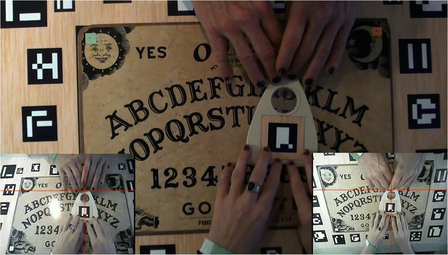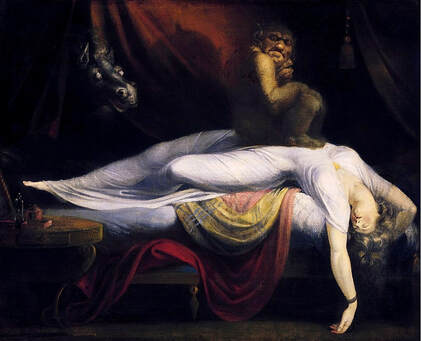 Using the Ouija Board Using the Ouija Board Human beings have used devices such as pendulums or dowsing rods for the purposes of divination for hundreds of years. By comparison the Ouija board is a late comer to this assortment of divination devices. In the United States, the businessman, Elijah Bond, patented the first Ouija Board, and his company, Kennard Novelty Company, began selling it in 1890. The generic Ouija board is a flat board with the letters of the alphabet, the numbers from 0 to 9, and the words “yes’ and “no” inscribed upon it. Upon this board a smaller board (planchette) is placed. The players place their fingertips on the planchette and ask questions. The planchette then moves and points to letters, numbers, “yes” or “no” to answer the questions. The people using the Ouija board claim that they do not move the planchette, and interpret the movement to be a product of entities such as “spirits” or “forces”. The Ouija board became very popular in the United States. Initially it was marketed as a parlor game, but it quickly began to be associated with the spiritualist movement whose members employed the board to contact spirits. Soon everyone was using the Ouija from socialites and writers, to crime solvers and gamblers. The board even made it to episodes of popular sitcoms like I Love Lucy and Bewitched, and in its heyday outsold other iconic games like Monopoly. During this time the Ouija board was considered at most a harmless pastime until Hollywood decided to demonize it. The first movie that posited that the Ouija board could serve as a tool for demonic possession was The Exorcist, in 1973. From then on, a string of movies have employed the trope of the Ouija board as a conduit for evil, and the Ouija board has been condemned by Christian organizations.  Demonic Possession Demonic Possession Ouija boards and other divining devices such as pendulums and dowsing rods work based on a well-studied psychological effect called the “ideomotor effect”. This is a dissociative state: a situation where movement becomes dissociated from consciousness. The planchette in the Ouija board is unconsciously moved by the person(s) touching it. The effect is so realistic that many people operating the Ouija board swear that they are not moving the planchette at all, but rather that they merely allow their hands to be carried by its movements. If susceptible individuals operating the Ouija board believe that the planchette is indeed moved by spirits, and that the board is a gateway to the occult, this can have a powerful suggestive effect on the operators who, in some cases, have experienced an array of symptoms that can include trance states, convulsions, or hallucinations. Depending on the cultural background of the people involved, this can be interpreted as demonic possession. However, in none of these cases has anything supernatural been proven to occur. People convulsing and making weird noises can create quite an impression on others, but their behavior has always been found to be within the realm of the possible. Individuals operating Ouija boards do not gain access to information that they would otherwise not know or not be able to figure out by themselves. If people try to operate the Ouija board blindfolded, the movement effect persists, but the answer to questions becomes nonsensical. Episodes where dozens to hundreds of people ended up acting out directly or indirectly as a result of using divination games like the Ouija have been the result of hysteria, or what is called nowadays “conversion disorder”. This is a disorder where the emotional problems, stresses, and anxieties of individuals are expressed in the form of physical symptoms. Scientists have simply not found any evidence that Ouija boards or other divination devices work, or that they are in any way related to anything supernatural. Nevertheless, the general recommendation is that anxious individuals prone to emotional or neurological problems should not use these devices. However, I believe the real danger regarding things like Ouija boards and demonic possession lies in accepting them as real. Back in 1691 in the town of Salem in Massachusetts a group of girls started exhibiting strange behaviors including altered speech, convulsions, and trance-like states. The local physician examined the girls and concluded that they were victims of witchcraft. The town’s government accepted this diagnosis and asked the girls to name their tormentors, whom they proceeded to jail and try in court for witchcraft. Salem spiraled into madness as the girls’ accusations placed hundreds of innocent people in jail with 20 of them being led to the gallows. I recently visited Salem and went to a memorial dedicated to those executed during the Salem witch trials. The names of these people are engraved into stone slabs in the memorial. They represent an unsettling testament to what can happen when fear and hysteria leads to the uncritical acceptance of questionable beliefs. The American Horror writer H.P. Lovecraft wrote: “The oldest and strongest emotion of mankind is fear, and the oldest and strongest kind of fear is fear of the unknown.” I certainly think Lovecraft was on to something, but we have science, and science allows us to know. With science we can discover how things work, what is possible, and what is not. The best evidence we have indicates that divination devices do not work, demonic possession does not happen, and witches do not exist. Although it is often both culturally and psychologically difficult to avoid fearing these things, understanding their real nature using science can help us achieve this. But for this to happen, we have to incorporate science into the way we think, and use it to select which beliefs to hold. Ouija board use photo taken from the article by Marc Andersen, Kristoffer L. Nielbo, Uffe Schjoedt, Thies Pfeiffer, Andreas Roepstorff, and Jesper Sørensen - (2018-07-17). "Predictive minds in Ouija board sessions". Phenomenology and the Cognitive Sciences. DOI:10.1007/s11097-018-9585-8. ISSN 1572-8676. Retrieved on 2019-01-13., CC BY-SA 4.0, https://commons.wikimedia.org/w/index.php?curid=75826799 The painting The Nightmare by John Henry Fuseli is in the public domain. Photos of the Salem Witch Trial Memorial belong to the author and can only be used with permission.
0 Comments
Your comment will be posted after it is approved.
Leave a Reply. |
Details
Categories
All
Archives
June 2024
|
 RSS Feed
RSS Feed